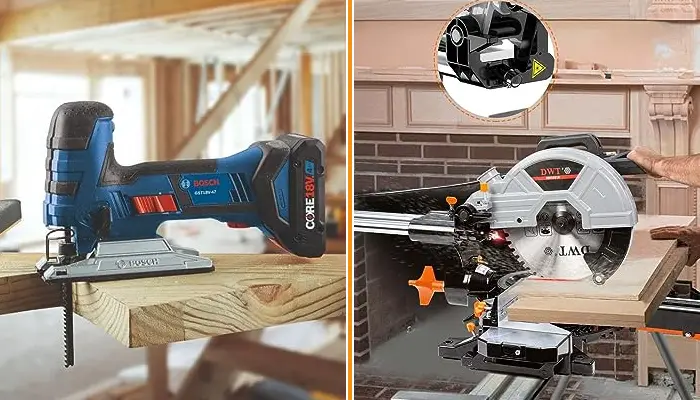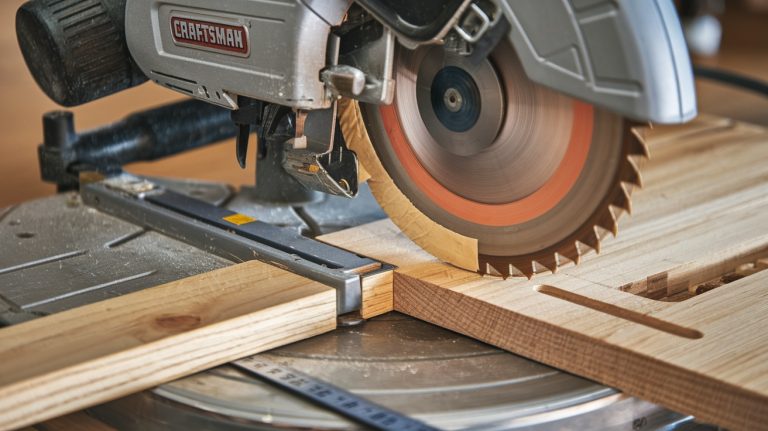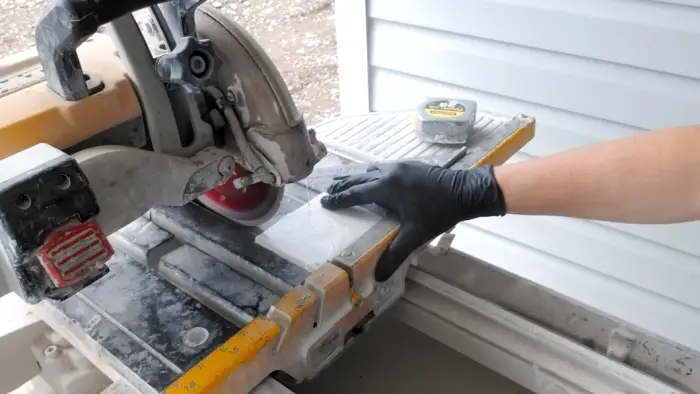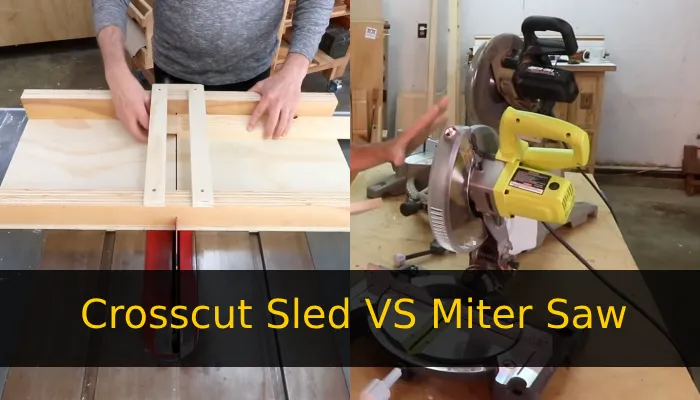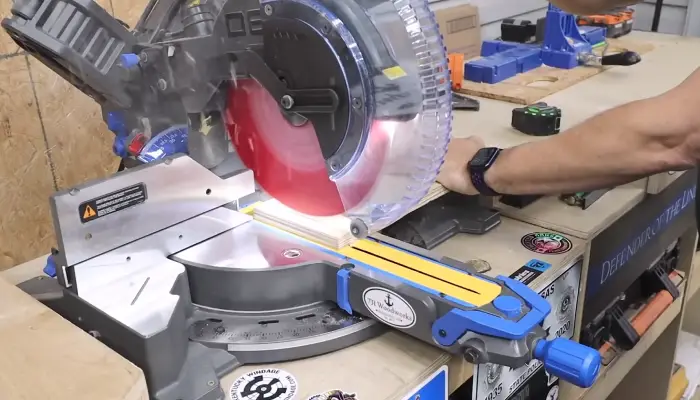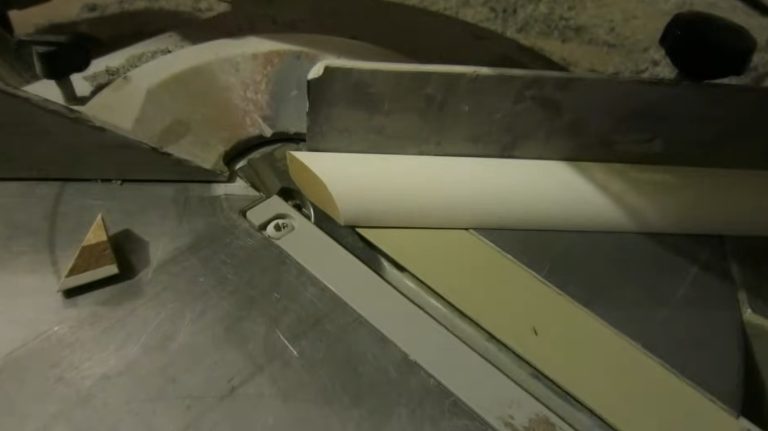Jigsaw vs Miter Saw: 9 Essential Differences
Do you ever wonder whether to buy a jigsaw or a miter saw in the tool aisle? These two powerful tools may seem similar at first glance, but their distinct differences make them suited for different tasks.
Jigsaws are handheld power tools with a reciprocating blade, while miter saws are stationary saws with a circular blade mounted on a pivoting arm.
Regarding cutting abilities, jigsaws make intricate cuts and curves, while miter saws are ideal for accurate angle cuts (45°) and miter cuts.
Here, we’ll break down the top differences between the jigsaw and miter saw, so you can make an informed decision and choose the right tool for your next project.
Differences Between Jigsaw vs Miter Saw
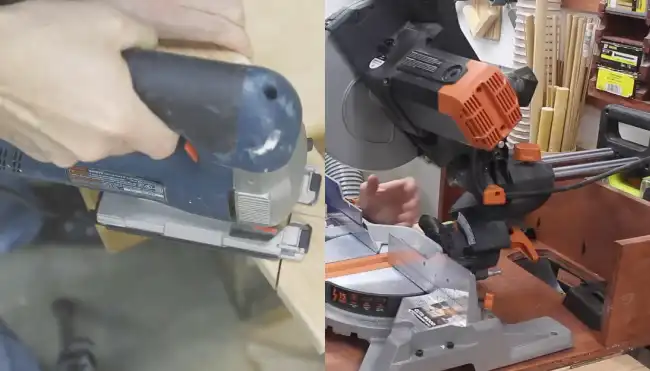
When comparing jigsaw and miter saws, several key distinctions exist. Here are some of the main differences:
- Tool type and design
- Cutting abilities
- Cutting types
- Cutting depth and materials
- Blade speed
- Blade rigidity
- Dust collection
- Storage and portability
- Cost
Let’s explore each difference in more detail.
No 01: Tool Type and Design
If you’re looking for a handheld tool that offers versatility and the ability to cut various shapes, the jigsaw might be the right choice for you.
The jigsaw is a portable handheld power tool with a vertical reciprocating blade. Its design allows for easy maneuverability and use in different situations.
On the other hand, the miter saw is typically mounted on a sturdy frame and is designed for making straight and angled cuts with precision.
No 02: Cutting Abilities
The jigsaw’s ability to cut intricate shapes and designs sets it apart from the miter saw. With its versatile blade, the jigsaw can effortlessly navigate through curves, making it the go-to tool for projects that require artistic and detailed cuts.
Whether you’re creating intricate patterns on wood or cutting out precise shapes from metal or plastic, the jigsaw is your best companion.
In contrast, the miter saw excels at making accurate straight cuts and angles, making it ideal for tasks like framing and trim work. While it may have its limitations regarding intricate cuts, the miter saw’s precision and efficiency make it a valuable tool for any woodworking or construction project.
No 03: Cutting Types
You’ll find that the jigsaw and miter saw each have their specialties for various cutting types.
The jigsaw is perfect for making curved cuts, intricate detailed cuts, and notches. Its ability to maneuver around corners and tight spaces makes it a versatile tool for creating intricate designs or cutting out patterns.
However, the miter saw takes the lead when it comes to straight and angled cuts. This tool is specifically designed for making precise angle cuts, bevel cuts, and compound cuts. Its stable base and adjustable angles allow for accurate and clean cuts every time.
No 04: Cutting Depth and Materials
When working with different materials, the cutting depth of a jigsaw can be adjusted to accommodate varying thicknesses and densities. This is made possible by the interchangeable blades that the jigsaw offers.
You can ensure a precise and efficient cut by selecting the appropriate blade for the material you are working with.
The jigsaw’s versatility allows it to cut through various materials such as wood, metal, ceramics, and plastics. On the other hand, for a miter saw, the size of its circular blade determines cutting depth.
While miter saws are excellent for wood and aluminum, their cutting capabilities are limited to the material’s thickness and the blade’s size.
No 05: Blade Speed
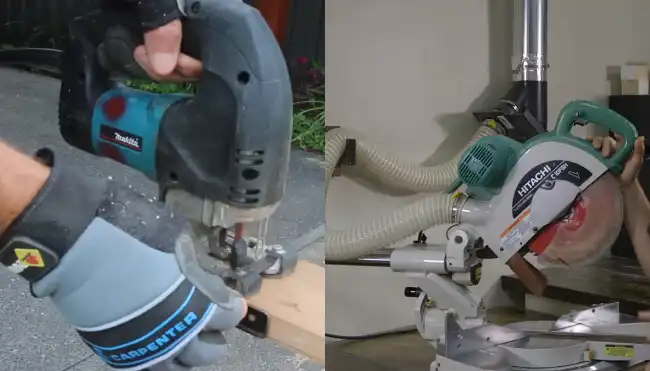
The blade speed is a key factor in determining the efficiency and performance of both jigsaws and miter saws.
Regarding jigsaws, their smaller blades and intricate cutting capabilities result in slower blade speeds compared to miter saws. This makes jigsaws more suitable for detailed and precise cuts rather than quick completion of projects.
On the other hand, miter saws are designed to be faster and more efficient in making cuts. With their larger blades and higher blade speeds, miter saws excel in swiftly cutting through various materials. This makes them ideal for projects that require a quick turnaround time.
No 06: Blade Rigidity
Jigsaw blades, due to their thinness and flexibility, can sometimes bend during cutting, which can affect the straightness of the cut. As opposed to this, miter saw blades are designed to be rigid, ensuring straight cuts with minimal bending.
This rigidity increases precision and accuracy, especially when making angled cuts or working with thicker materials. So, if you prioritize straight cuts and need a tool that can handle more rigid cutting tasks, a miter saw would be your better choice.
No 07: Dust Collection
To keep your work area cleaner, you’ll appreciate the dust collection feature on a miter saw. Unlike jigsaws, miter saws are designed with a built-in dust collection system that helps to minimize the amount of sawdust generated during cutting.
This feature is especially beneficial when working in enclosed spaces or when you want to maintain a tidy work environment. The dust collection system on a miter saw typically consists of a dust bag or a vacuum attachment that captures the sawdust as it is created, preventing it from spreading all over your work area.
While jigsaws don’t have the same dust collection capacity as a miter saw, you can still reduce the amount of sawdust created by using a vacuum attachment or dust collection system. Additionally, by wearing safety glasses and a dust mask, you can help to limit your exposure to dangerous particles while using either type of saw.
No 08: Storage and Portability
When considering storage and portability, you’ll find that jigsaws are a more convenient option due to their compact size and easy transportability.
Jigsaws are handheld and designed to be compact, making them easier to store in your workshop or transport to different locations. Their small size allows for easy maneuverability and access to tight spaces.
Alternatively, miter saws are usually larger and attached to a table or workbench, limiting their portability. Due to their stationary nature, miter saws are best suited for tasks within a workshop.
No 09: Cost
Considering the cost, jigsaws are generally more affordable than miter saws, making them a budget-friendly option for woodworkers. While both tools serve different purposes, the jigsaw provides versatility at a lower price point.
However, with their advanced features and specialized functionality, miter saws tend to be more expensive. So, if you are a woodworker on a budget, the jigsaw is a cost-effective choice that still delivers reliable performance and versatility.
Comparison Table Between Jigsaw and Miter Saw
| Features | Jigsaw | Miter Saw |
| Tool Type and Design | Portable handheld reciprocating saw | Mounted, circular saw on a frame |
| Cutting Abilities | Straight, curved, intricate cuts | Straight and angled cuts |
| Cutting Depth | Varies by material and blade | Limited by blade size |
| Cutting Types | Curves, intricate cuts notches | Straight, angle, bevel cuts |
| Blade Speed | Slower, more intricate cuts | Faster, efficient cuts |
| Blade Rigidity | Thin, flexible blades | Rigid blades for minimal bending |
| Dust Collection | Typically lacks built-in system | Often equipped with dust collection |
| Storage and Portability | Portable, suitable for various sites | Less portable, suited for stationary use |
| Cost | Generally less expensive | Often more expensive |
How thick can a jigsaw cut?
Jigsaws are versatile tools that are great for cutting softwood that is no more than 1-1/2 in. thick and hardwood up to 3/4 in. thick. However, it’s important to note that jigsaw blades will bend and leave a beveled edge when cutting curves in thicker boards.
If you’re working with thicker wood, it might not be the best option for precise and accurate cuts. Instead, consider using a circular or miter saw for thicker wood but always take a safety approach.
Is a miter saw a circular saw?
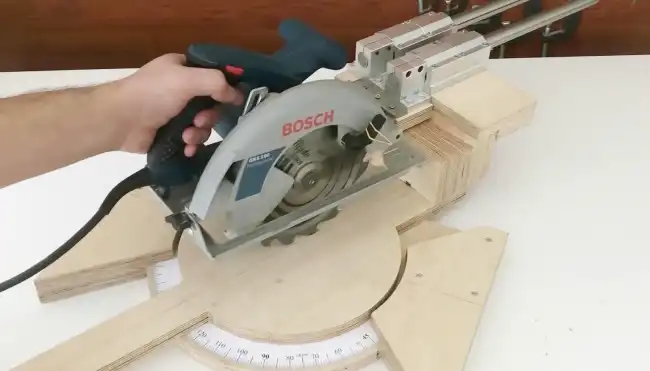
While a miter and a circular saw may look similar, they are two different tools with their own strengths and weaknesses.
A miter saw is stationary, with a blade that is pulled downward onto the wood and is great for making precise cuts at different angles.
On the other hand, a circular saw is handheld and is best for making long, straight cuts in larger pieces of wood.
So, while they can both be used for similar tasks, they each have their area of expertise. Choosing the right tool for the job is important to get the best results.
Choose the Perfect Saw: Miter or Jigsaw
When choosing between a jigsaw and a miter saw, you must consider your specific needs and tasks.
The miter saws precision, efficiency, and accuracy make it an excellent choice for straight and angled cuts, especially for framing and trim work. Conversely, the jigsaw’s versatility, portability, and ability to create intricate shapes and designs make it indispensable for tasks requiring curved and detailed cuts.
Interestingly, statistics show that the miter saw is the preferred option among professional woodworkers, with a usage rate of 65%.

